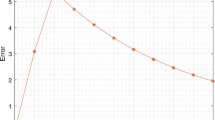Abstract
This paper presents a precise method for solving singularly perturbed boundary-value problems with the boundary layer at one end. The method divides the interval evenly and gives a set of algebraic equations in a matrix form by the precise integration relationship of each segment. Substituting the boundary conditions into the algebraic equations, the coefficient matrix can be transformed to the block tridiagonal matrix. Considering the nature of the problem, an efficient reduction method is given for solving singular perturbation problems. Since the precise integration relationship introduces no discrete error in the discrete process, the present method has high precision. Numerical examples show the validity of the present method.
Similar content being viewed by others
References
Su, Y. C. The Boundary Layer Correction Method in the Singular Perturbations (in Chinese), Science and Technology Press, Shanghai (1983)
Kadalbajoo, M. K. and Reddy, Y. N. Asymptotic and numerical analysis of singular perturbation problems: a survey. Applied Mathematics and Computation 30, 223–259 (1989)
Chawla, M. M. A fourth-order tridiagonal finite difference method for general non-linear two-point boundary value problems with mixed boundary conditions. Journal of the Institute of Mathematics and Its Applications 21, 83–93 (1978)
Su, Y. C. and Wu, Q. G. An Introduction to Numerical Methods for the Singular Perturbation Problems (in Chinese), Chongqing Publishing House, Chongqing (1991)
Andargie, A. and Reddy, Y. N. Fitted fourth-order tridiagonal finite difference method for singular perturbation problems. Applied Mathematics and Computation 192, 90–100 (2007)
Stynes, M. and O’Riordan, E. A uniformly accurate finite-element method for a singular perturbation problem in conservative form. SIAM Journal on Numerical Analysis 23, 369–375 (1986)
Vigo-Aguiar, J. and Natesan, S. A parallel boundary value technique for singularly perturbed two-point boundary value problems. The Journal of Supercomputing 27, 195–206 (2004)
Reddy, Y. N. and Chakravarthy, P. P. An initial-value approach for singularly perturbed two-point boundary value problems. Applied Mathematics and Computation 155, 95–110 (2004)
Kadalbajoo, M. K. and Kumar, D. Initial value technique for singularly perturbed two-point boundary value problems using an exponentially fitted finite difference scheme. Computers and Mathematics with Applications 57, 1147–1156 (2009)
Aziz, T. and Khan, A. A spline method for second-order singularly perturbed boundary-value problems. Journal of Computational and Applied Mathematics 147, 445–452 (2002)
Tirmizi, I. A., Fazal-i-Haq, and Siraj-ul-Islam. Non-polynomial spline solution of singularly perturbed boundary-value problems. Applied Mathematics and Computation 196, 6–16 (2008)
Zhong, W. X. and Williams, F. W. A precise time step integration method. Proceedings of the Institute of Mechanical Engineers, Part C, Journal of Mechanical Engineering Science 208(C6), 427–430 (1994)
Lin, J. H., Sun, D. K., Zhong, W. X., and Zheng, W. S. High efficiency computation of the variances of structural evolutionary random responses. Shock and Vibration 7(4), 209–216 (2000)
Gu, Y. X., Chen, B. S., Zhang, H. W., and Grandhi, R. V. A sensitivity analysis method for linear and nonlinear transient heat conduction with precise time integration. Structural and Multidisciplinary Optimization 24, 23–37 (2002)
Zhang, H. W., Zhang, X. W., and Chen, J. S. A new algorithm for numerical solution of dynamic elastic-plastic hardening and softening problems. Computers and Structures 81(17), 1739–1749 (2003)
Zhong, W. X. Combined method for the solution of asymmetric Riccati differential equations. Computer Methods in Applied Mechanics and Engineering 191, 93–102 (2001)
Chen, B. S., Tong, L. Y., and Gu, Y. X. Precise time integration for linear two-point boundary value problems. Applied Mathematics and Computation 175, 182–211 (2006)
Fu, M. H. and Lin, J. H. An exponential matrix function and its application (in Chinese). Acta Mechanica Sinica 41(5), 808–814 (2009)
Tan, S. J. and Zhong, W. X. Precise integration method for Duhamel terms arising from nonhomogenous systems (in Chinese). Acta Mechanica Sinica 39(3), 374–381 (2007)
Wang, M. F. and Zhou, X. Y. Renewal precise time step integration method of structural dynamic analysis. Acta Mechanica Sinica 36(2), 191–195 (2004)
Ren, C. B., He, G. Z., and Li, Z. F. A high-precision and general computational scheme in precise integration of structural dynamics (in Chinese). Mechanical Science and Technology 24(2), 1507–1509 (2005)
Fu, M. H. and Liang, H. L. An improved precise Runge-Kutta integration (in Chinese). Acta Scientiarum Naturalium Universitatis Sunyatseni 48(5), 1–5 (2009)
Author information
Authors and Affiliations
Corresponding author
Additional information
Communicated by Xing-ming GUO
Project supported by the National Natural Science Foundation of China (No. 10672194) and the China-Russia Cooperative Project (the National Natural Science Foundation of China and the Russian Foundation for Basic Research) (No. 10811120012)
Rights and permissions
About this article
Cite this article
Fu, Mh., Cheung, Mc. & Sheshenin, S.V. Precise integration method for solving singular perturbation problems. Appl. Math. Mech.-Engl. Ed. 31, 1463–1472 (2010). https://doi.org/10.1007/s10483-010-1376-x
Received:
Revised:
Published:
Issue Date:
DOI: https://doi.org/10.1007/s10483-010-1376-x
Key words
- singular perturbation problem
- first-order ordinary differential equation
- two-point boundary-value problem
- precise integration method
- reduction method




